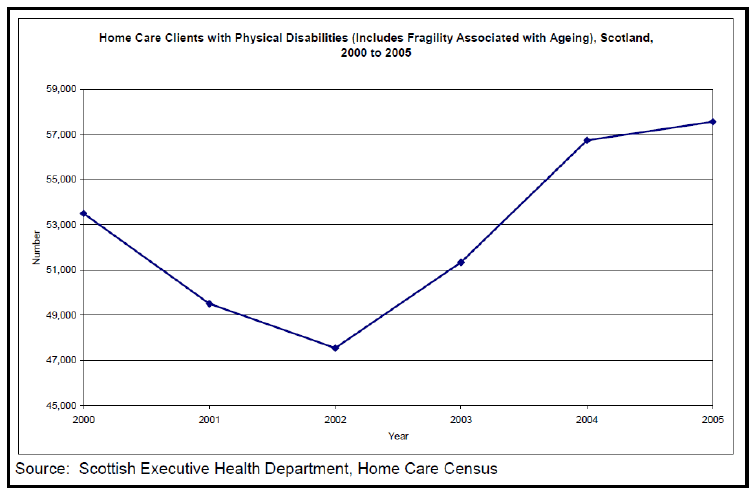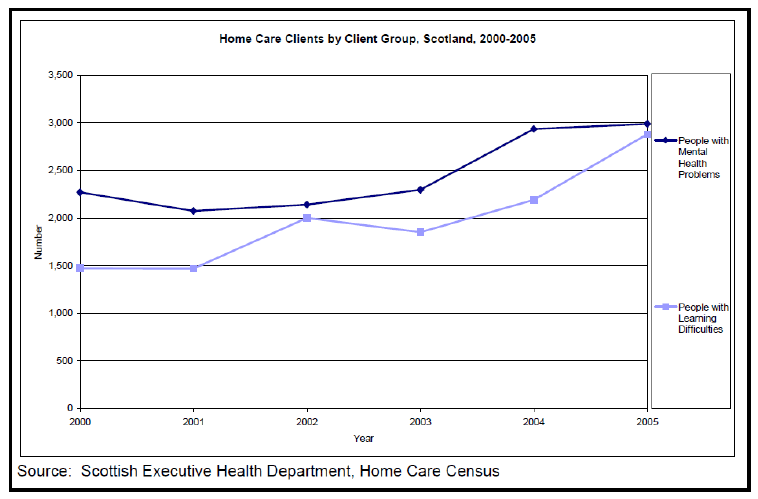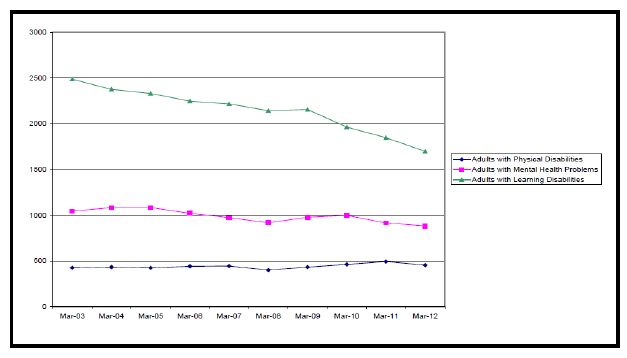Scottish Government Equality Outcomes: Disability Evidence Review
This evidence review was prepared to support the production of the Scottish Government's Equality Outcomes, with regard to disability.
13 Social care
13.1 This section reviews the provision of care to disabled people in their homes, including the adequacy of support and who provides that support. It then looks at the number of care homes.
Home care
13.2 In Scotland in 2012, local authorities provided or purchased Home Care Services[92] for clients of whom 17,526 (28%) had physical disabilities, 31,415 (50%) had infirmity due to age, and 4,588 (7%) had learning disabilities.
13.3 Earlier data on home care is not directly comparable to the 2012 data because the Home Care Services statistical data collection was substantially revised in 2010. This earlier data is presented below (figures 7 and 8) to show trends in home care provision between 2000 and 2005. The High-level Summary of Equality Statistics[93] (2006) plots the increasing numbers of disabled people being cared for at home. The number of home care clients with physical disabilities (including frailty due to old age) has increased by over 10,000 since 2002, to its 2005 level of just over 57,500 (see Figure 7). This has been largely driven by the rise in the number of people aged 65 and over in this category with an increase of almost 9,000 since 2002, mainly due to the introduction of Free Personal Care in July 2002.

Figure 7: Care at home and physical disability
13.4 Since 2000, the number of adults with learning disabilities receiving home care has risen from just under 1,500 to just under 3,000 (a rise of 96%, see Figure 8). During the same period the number of adults with mental health problems receiving home care also rose from just over 2,200 to just under 3,000 (a rise of 32%).

Figure 8: Care at home and mental health/ learning difficulties
13.5 The EHRC Triennial Review[94] (2011) reports on a large scale GB-wide research study in 2008, The Experiences and Expectations of Disabled People[95]. This had both qualitative and quantitative elements, and it reported on the care and support experiences at home of disabled people. As part of the research for the project, a survey of 7,000 disabled people was completed, in addition to qualitative work with 134 disabled individuals. The majority of respondents to the survey (86%) said that they did not have any unmet needs for help and support for day to day activities or less regular tasks. However, the remaining 14% of respondents said they needed some kind of help that they were not currently receiving. This figure was higher among women (16%) than men (12%). The degree to which support needs were met appears to be influenced by a number of characteristics:
- Those in single person households were more likely to report having unmet support needs (20%) than those in other households.
- Respondents in households with higher incomes were less likely than those with lower household incomes to say that they had an unmet support need: 12% of those with annual household incomes above £10,400 said this, compared with 19% of those with household incomes below this level. More than half of disabled people who have financial difficulties agreed that their financial situation had stopped them from getting the help or support they need.
13.6 The Triennial Review also refers to the Scottish Household Survey (2005-06), which reports on the percentage of people who have some illness or disability, who have difficulty with at least one activity, and have the adaptations/ equipment they need and receive satisfactory help. Initial analysis of the responses, as part of the development of the Equality Measurement Framework, shows that more women than men reported that they had the adaptations/equipment that they needed and that they received satisfactory help (42% compared with 34%). People over the age of 75 were also more likely to report that they had the adaptations/equipment that they needed, and that they received satisfactory help, than any other age group.
13.7 For disabled people responding to the survey reported in The Experiences and Expectations of Disabled People (2008), family members provided the greatest source of weekly help with more than 2 in 5 of those who received any help or support saying that their spouse or partner (46%) or child(ren) (43%) gave them help or support at least once a week. Overall, 41% of respondents received regular (at least once a week) support for some activity.
Care homes
13.8 As at 31st March 2012 there were[96]:
- 45 care homes for adults with physical disabilities, providing 644 places to 528 residents.
- 74 care homes for adults with mental health problems, providing 1,086 places to 960 residents.
- 249 care homes for adults with learning disabilities, providing 2,302 places to 1,962 residents.
13.9 Figure 9 illustrates a declining trend in the number of care home residents with learning disabilities since 2003, and relatively stable numbers with physical disabilities over the same period.

Figure 9: Number of Long Stay Residents in Care Homes for Other Client Groups, March 2003 to March 2012 (Source: Care home census 2012)
Contact
Email: Social Research
There is a problem
Thanks for your feedback